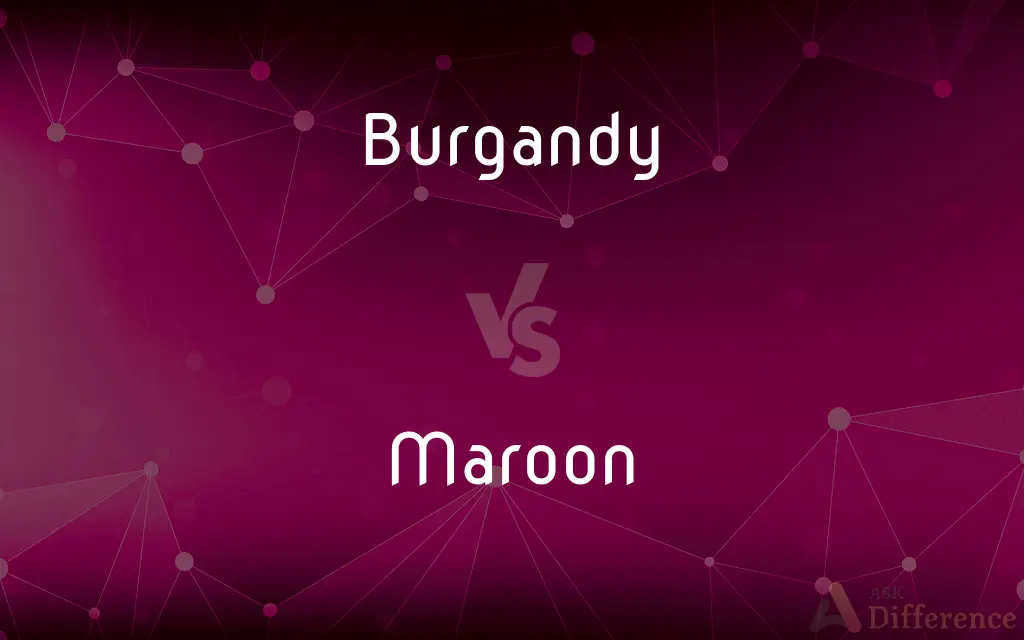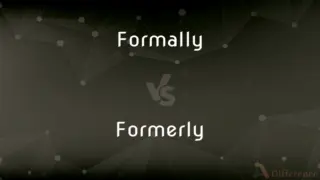Burgandy vs. Maroon — What's the Difference?
By Maham Liaqat & Fiza Rafique — Updated on April 25, 2024
"Burgundy" is a deep red color inspired by Burgundy wine, with a cooler, purple tone, while "maroon" is a darker shade of red derived from the French word for chestnut, showing warmer, browner undertones.

Difference Between Burgandy and Maroon
Table of Contents
ADVERTISEMENT
Key Differences
"Burgundy" is a color name that comes from the wine produced in the Burgundy region of France, characterized by a deep, rich red with a slight purple tint. This color is often associated with sophistication and luxury, frequently used in fashion, automotive, and interior design to convey a sense of richness. On the other hand, "maroon" originates from the French word 'marron,' meaning chestnut, and is a darker, more brownish-red color, which is generally warmer than burgundy.
While burgundy has a distinctly cooler undertone due to its purple base, making it lean towards a slightly bluish tint, maroon is predominantly red with a hint of brown, giving it a more earthy and warm appearance. This difference in undertones influences how each color is used in design and fashion; burgundy might be chosen for a bold yet refined look, whereas maroon could be selected for its more muted and natural feel.
In terms of cultural associations, both colors are often seen in formal wear and are popular choices for academic and ceremonial robes, though burgundy is frequently perceived as more luxurious or exclusive compared to the more commonly seen maroon. Additionally, both colors are popular in the branding and uniforms of educational institutions and sports teams, where they evoke tradition and endurance.
Despite their similarities, the context in which burgundy and maroon are used can significantly affect the mood and style they convey. Burgundy, with its cooler, more sophisticated undertone, is often used in products and designs intended to evoke a sense of luxury or cutting-edge fashion. In contrast, maroon, with its warmer and more subdued hue, is commonly used in settings that require a sense of strength and reliability.
Understanding the distinction between these two colors can aid in making more informed decisions in fashion, design, and branding, ensuring the intended emotional and visual impacts are achieved.
ADVERTISEMENT
Comparison Chart
Color Origin
Inspired by Burgundy wine
Comes from the French word for chestnut
Undertone
Cooler, purple tones
Warmer, brownish tones
Common Associations
Luxury, sophistication
Earthiness, warmth
Usage in Design
Fashion, luxury cars, interior design
School colors, uniforms, earthy decor
Emotional Impact
Conveys richness and exclusivity
Evokes strength and reliability
Compare with Definitions
Burgandy
Used in design to create a sophisticated ambiance.
The designer recommended burgundy for the leather upholstery.
Maroon
Derived from the word for chestnut, indicating earthy red tones.
Maroon is a popular color for autumn fashion.
Burgandy
Often associated with luxury and depth in color.
The new sedan comes in a sleek burgundy shade.
Maroon
Suggests durability and warmth in color psychology.
They painted the room maroon to make it feel cozy.
Burgandy
A deep purplish-red color.
She wore a burgundy dress to the gala.
Maroon
A dark brownish-red color.
His favorite sweater is maroon.
Burgandy
Relating to or denoting the rich red color of Burgundy wine.
The burgundy curtains added a touch of elegance to the room.
Maroon
Commonly used for school colors and uniforms.
The university’s official colors are maroon and white.
Burgandy
Symbolic of wealth and refinement in cultural contexts.
The official robes of the judges were a deep burgundy.
Maroon
Used in both fashion and interior design to evoke a grounded, robust feel.
She chose maroon tiles for the kitchen backsplash to add warmth.
Maroon
Maroon (US/UK mə-ROON, Australia mə-ROHN) is a brownish crimson color that takes its name from the French word marron, or chestnut. "Marron" is also one of the French translations for "brown".
Maroon
Of a brownish-red colour
Ornate maroon and gold wallpaper
Maroon
A member of any of various communities in parts of the Caribbean who were originally descended from escaped slaves. In the 18th century Jamaican Maroons fought two wars against the British, both of which ended with treaties affirming the independence of the Maroons.
Maroon
Leave (someone) trapped and alone in an inaccessible place, especially an island
A novel about schoolboys marooned on a desert island
Maroon
To put ashore on a deserted island or coast and intentionally abandon.
Maroon
To abandon or isolate with little hope of ready rescue or escape
The travelers were marooned by the blizzard.
Maroon
A fugitive black slave in the West Indies in the 1600s and 1700s.
Maroon
A descendant of such a slave.
Maroon
A person who is marooned, as on an island.
Maroon
A dark reddish brown to dark purplish red.
Maroon
An escaped negro of the Caribbean and the Americas or a descendant of such a person.
Maroon
A castaway; a person who has been marooned.
Maroon
A rich dark red, somewhat brownish, color.
Maroon
(nautical) A rocket-propelled firework or skyrocket, often one used as a signal (e.g. to summon the crew of a lifeboat or warn of an air raid).
Maroon
An idiot; a fool.
Maroon
Associated with Maroon culture, communities or peoples.
Maroon
Of a maroon color
Maroon
To abandon in a remote, desolate place, as on a desert island.
Maroon
In the West Indies and Guiana, a fugitive slave, or a free negro, living in the mountains.
Maroon
A brownish or dull red of any description, esp. of a scarlet cast rather than approaching crimson or purple.
Maroon
An explosive shell. See Marron, 3.
Maroon
To put (a person) ashore on a desolate island or coast and leave him to his fate.
Maroon
Having the color called maroon. See 4th Maroon.
Maroon
A person who is stranded (as on an island);
When the tide came in I was a maroon out there
Maroon
A dark purplish red to dark brownish red
Maroon
An exploding firework used as a warning signal
Maroon
Leave stranded or isolated withe little hope og rescue;
The travellers were marooned
Maroon
Leave stranded on a desert island without resources;
The mutinous sailors were marooned on an island
Maroon
Dark brownish to purplish red
Common Curiosities
Which color is more suitable for a formal event, burgundy or maroon?
Burgundy, often associated with luxury and sophistication, is typically more suitable for formal events.
What is the main difference between burgundy and maroon?
The main difference lies in their undertones: burgundy has a cooler, purplish tint, whereas maroon has warmer, browner hues.
How do lighting conditions affect the appearance of burgundy and maroon?
Burgundy can appear more purple or black in low light, while maroon may look richer and more intensely red.
Are there any famous brands that use burgundy or maroon in their logos?
Yes, several brands use these colors; for instance, maroon is notable in the logos of Alfa Romeo and UPS.
Which color is better for a corporate logo?
The choice depends on the emotional impact the company wants to convey: burgundy for luxury and sophistication, maroon for reliability and strength.
Can burgundy and maroon be used interchangeably?
While they are both dark reds, their different undertones mean they convey distinct moods and are not always interchangeable in design.
Is burgundy more popular in fashion than maroon?
Burgundy tends to be more popular in high fashion due to its association with luxury and its depth of color.
What psychological effects do burgundy and maroon have?
Burgundy can evoke feelings of power and ambition, whereas maroon can feel more protective and comforting.
What are the best uses for maroon in home decor?
Maroon works well in home decor for creating a warm, welcoming environment, especially in living areas and bedrooms.
Which color is preferred in academic robes?
Both colors are used, but burgundy is often seen in more exclusive or higher education contexts, while maroon is widely used across various educational institutions.
How does the use of burgundy and maroon differ in fashion?
Burgundy is often used for statement pieces and luxury items, while maroon is a common choice for everyday and mass-market apparel.
How should these colors be used in marketing?
Use burgundy to appeal to high-end consumers and maroon for campaigns that want to evoke trust and comfort.
Can the use of these colors affect the mood of a room?
Absolutely, burgundy can make a room feel more opulent and dramatic, while maroon can make it feel more secure and stable.
What are some tips for matching these colors in outfits?
Pair burgundy with neutral tones for elegance, or mix maroon with other warm colors for a cozy, autumnal look.
What cultural significance do these colors hold?
Both colors have cultural significance in terms of wealth, tradition, and formality in various societies.
Share Your Discovery

Previous Comparison
Formally vs. Formerly
Next Comparison
CST vs. ESTAuthor Spotlight
Written by
Maham LiaqatCo-written by
Fiza RafiqueFiza Rafique is a skilled content writer at AskDifference.com, where she meticulously refines and enhances written pieces. Drawing from her vast editorial expertise, Fiza ensures clarity, accuracy, and precision in every article. Passionate about language, she continually seeks to elevate the quality of content for readers worldwide.
















































